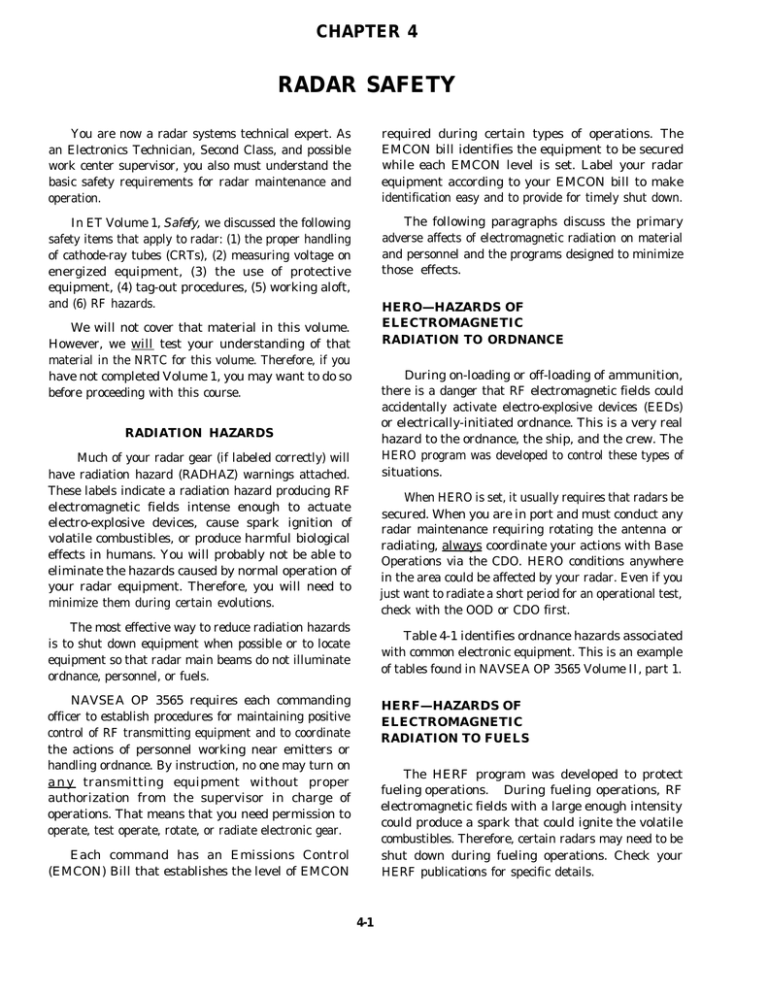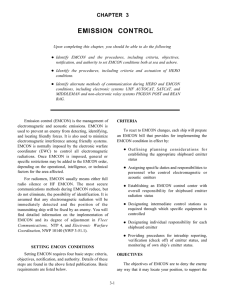RADAR SAFETY CHAPTER 4
advertisement

CHAPTER 4 RADAR SAFETY You are now a radar systems technical expert. As an Electronics Technician, Second Class, and possible work center supervisor, you also must understand the basic safety requirements for radar maintenance and operation. required during certain types of operations. The EMCON bill identifies the equipment to be secured while each EMCON level is set. Label your radar equipment according to your EMCON bill to make identification easy and to provide for timely shut down. In ET Volume 1, Safefy, we discussed the following safety items that apply to radar: (1) the proper handling of cathode-ray tubes (CRTs), (2) measuring voltage on energized equipment, (3) the use of protective equipment, (4) tag-out procedures, (5) working aloft, and (6) RF hazards. The following paragraphs discuss the primary adverse affects of electromagnetic radiation on material and personnel and the programs designed to minimize those effects. HERO—HAZARDS OF ELECTROMAGNETIC RADIATION TO ORDNANCE We will not cover that material in this volume. However, we will test your understanding of that material in the NRTC for this volume. Therefore, if you have not completed Volume 1, you may want to do so before proceeding with this course. During on-loading or off-loading of ammunition, there is a danger that RF electromagnetic fields could accidentally activate electro-explosive devices (EEDs) or electrically-initiated ordnance. This is a very real hazard to the ordnance, the ship, and the crew. The HERO program was developed to control these types of situations. RADIATION HAZARDS Much of your radar gear (if labeled correctly) will have radiation hazard (RADHAZ) warnings attached. These labels indicate a radiation hazard producing RF electromagnetic fields intense enough to actuate electro-explosive devices, cause spark ignition of volatile combustibles, or produce harmful biological effects in humans. You will probably not be able to eliminate the hazards caused by normal operation of your radar equipment. Therefore, you will need to minimize them during certain evolutions. When HERO is set, it usually requires that radars be secured. When you are in port and must conduct any radar maintenance requiring rotating the antenna or radiating, always coordinate your actions with Base Operations via the CDO. HERO conditions anywhere in the area could be affected by your radar. Even if you just want to radiate a short period for an operational test, check with the OOD or CDO first. The most effective way to reduce radiation hazards is to shut down equipment when possible or to locate equipment so that radar main beams do not illuminate ordnance, personnel, or fuels. Table 4-1 identifies ordnance hazards associated with common electronic equipment. This is an example of tables found in NAVSEA OP 3565 Volume II, part 1. NAVSEA OP 3565 requires each commanding officer to establish procedures for maintaining positive control of RF transmitting equipment and to coordinate the actions of personnel working near emitters or handling ordnance. By instruction, no one may turn on a n y transmitting equipment without proper authorization from the supervisor in charge of operations. That means that you need permission to operate, test operate, rotate, or radiate electronic gear. HERF—HAZARDS OF ELECTROMAGNETIC RADIATION TO FUELS The HERF program was developed to protect fueling operations. During fueling operations, RF electromagnetic fields with a large enough intensity could produce a spark that could ignite the volatile combustibles. Therefore, certain radars may need to be shut down during fueling operations. Check your HERF publications for specific details. Each command has an Emissions Control (EMCON) Bill that establishes the level of EMCON 4-1 Table 4-1.—NAVSEA OP 3565 Volume II, Table 2-4, Safe Separation Distances for Radar, EW, and NAVAIDS Equipment example of tables found in NAVSEA OP 3565 Volume I. HERP—HAZARDS OF ELECTROMAGNETIC RADIATION TO PERSONNEL RF BURNS.— As we mentioned in ET Volume 1, voltages of enough potential to cause a burn injury can be induced on metallic items from nearby transmitting antennas. However, there has to be actual physical contact for the burn to occur. You can help prevent contact by ensuring that warning signs are placed properly and obeyed. The HERP program was developed to protect personnel from RF electromagnetic radiation. Anywhere a radar or transmitter is operating, there is a danger that the RF electromagnetic fields may produce harmful biological effects in humans exposed to them. The following paragraphs identify the typical hazards and the steps you can take to minimize them. Precautions Hazards RF hazards to personnel are based on overexposure to RF energy. The biological hazard level for exposure to RF radiationis established by the Bureau of Medicine and Surgery and is included in NAVSEA OP 3565 Volume I. During normal operations, personnel can easily avoid most hazards if the hazards are labeled properly. However, during maintenance, some hazards must be eliminated by specific, planned actions, such as those listed below. Using all safety precautions is the personal responsibility of the technician. SAFE LIMITS.— Safe limits are based on the power density of the radiation beam and the exposure time of the human body. Table 4-2 identifies safe limits associated with common electronics equipment. It is an TAG-OUT.— Tag-out procedures are covered in depth in ET Volume 1. Hanging a proper tag can save your life. Using tags improperly or not at all will eventually put you, maybe your best buddy, maybe your 4-2 Table 4-2.—NAVSEA OP 3565, Volume I, Table 2-1, Personnel Hazards from Continuous or Intermittent Exposure to Main Beam Radiation whole crew, in a Navy mishap report. Ensure that required tags are installed properly and observed fully. become familiar with the hazards associated with your equipment. If you install new equipment, update your EMCON bill. Use NAVSEA OP 3565 Volume I or Volume II to determine the hazards associated with the equipment. MAN-ALOFT CHITS.— Man-Aloft chits protect you from RF hazards when you are working on radar antennas. If the chit is run properly, the operations on your ship and any ship next to you are modified to keep you safe. Heed the requirements and follow the procedures. OTHER RADAR HAZARDS You cannot always avoid hazards when working on radars. In these instances, take what precautions you can and at least be prepared for an emergency. As we discussed in ET Volume 1, there are various safety concerns associated with working on energized equipment, going aloft, or handling CRTs. EQUIPMENT SAFETY DEVICES.— Devices built into equipment, such as cut-off switches on antennas, are for your safety. A cut-off switch, when set, will keep you out of danger. It will prevent someone from rotating the antenna from a remote location. But, you, the technician, have to set the cut-off switch for it to be of any use. Equipment safety devices are there for your protection. Use them! ENERGIZED EQUIPMENT You may have to work on energized equipment on a hectic bridge, in a crowded CIC, or in a cramped radar equipment room. These are not ideal safety environments. As these spaces are maintained by various people, always check the rubber matting around your equipment. Also check other protective Everywhere you go in the Navy, there will be communications and radar equipment that produces an Electromagnetic Radiation Environment (EME). And, there will always be electromagnetic radiation hazards introduced by operating this equipment. To be safe, 4-3 equipment, such as rubber gloves and shorting probes before using them. It’s your life; pick good safety observers. Your safety observers should be aware of what type of maintenance you’re going to do. They also need to know whom to contact if you run into technical problems. WARNING! NEVER WORK ALONE ON ENERGIZED EQUIPMENT. Safety Observers are responsible for the safety of those walking underneath you as well as for your safety. They should position themselves so you can communicate with them without having to come down. The safety observer will pass your information to everyone else. If something is falling, communicate quickly. On ships with minimum manning, you may not have the option of using another ET as a safety observer. Make sure that whoever is going to observe you is CPR qualified. Brief your observer on what you will be doing. Physically show him or her where the cut-off switch is located. Have him or her stand by at a safe distance with a rope or wooden cane to pull you from the equipment, should you get hung up. Follow procedures outlined in ET Volume 1 for voltage checks. CATHODE-RAY TUBES (CRT’S) Cathode-ray tubes are part of radar scopes. You will definitely have to work around them. You will probably, at one time or another, pack or unpack, install, repair, or dispose of one. There are some very real dangers associated with handling a CRT. Always take the precautions discussed in ET Volume 1 whenever you handle a CRT. MAN-ALOFT As we mentioned earlier, when you work aloft on radar antennas, your man-aloft chit protects you from the RF radiation hazards. But, you also need to be protected from falling. Do the required PMS for safety harnesses every time you use the harness. And remember, even a good harness can’t save you unless you use it right. When you go up the mast attach your harness properly so you can’t free fall to the deck. Attach a line to any tools you carry up, so they are unable to fall freely. Set the cut-off switches for any antennas along your way. Never think about electronics without thinking about safety. Learn from the safety information you get from the Ship’s Safety Bulletins, Navy mishap reports, and personal experience. Follow established procedures and all safety instructions. Live longer. We’ve discussed many aspects of radar in this volume. In ET Volume 7, Antennas and Wave Propagation, we will provide specific information about radar antennas, waveguides, and transmission lines. Then in ET Volume 8, System Concepts, we will discuss specifics on radar cooling systems. WARNING! NEVER WORK ALOFT WITHOUT A SAFETY OBSERVER. 4-4




